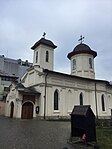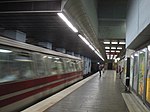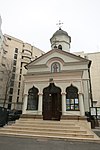The Mark (Bucharest)
The Mark, is a class A office building that is constructed in the north-western part of Bucharest in the vicinity of the Bucharest North railway station. The building has a total of 15 floors with two underground, one ground and 14 upground floors and a gross leasable area of 24,000 m2 (260,000 sq ft). At completion the 70 m (230 ft) high building is one of the tallest in Bucharest. The construction of the building started in March 2016 and was finished in 2019 at a total cost of €66 million.The project was announced for development in 2012 but was put on hold soon after by its developer, the real estate branch of the Austrian Erste Group, due to other large construction works underwent in the area. The project also comprises a second smaller six floor office building named The Podium with a gross leasable area of around 21,500 m2 (231,000 sq ft).
Excerpt from the Wikipedia article The Mark (Bucharest) (License: CC BY-SA 3.0, Authors).The Mark (Bucharest)
Calea Griviței, Bucharest Gara de Nord (Sector 1)
Geographical coordinates (GPS) Address Website Nearby Places Show on map
Geographical coordinates (GPS)
| Latitude | Longitude |
|---|---|
| N 44.446333333333 ° | E 26.080722222222 ° |
Address
Infosys Consulting Romania
Calea Griviței 84-98
011014 Bucharest, Gara de Nord (Sector 1)
Romania
Open on Google Maps







